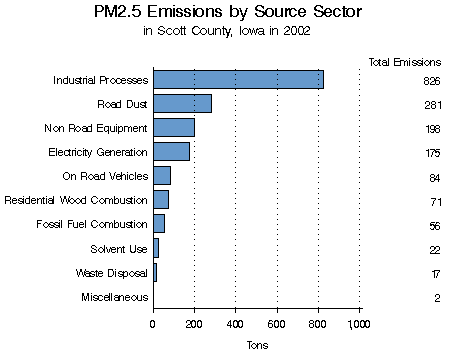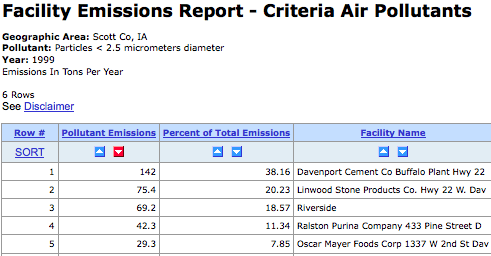by Ed Tibbetts, Iowa Capital Dispatch
May 16, 2024
First, the good news: Most Americans trust juries.
Now, the bad news... more

The U.S. Environmental Protection Agency plans to designate Scott and Rock Island Counties as "non-attainment" areas for fine particulate pollution.
The Iowa Department of Natural Resources and the Governor's Office have sent letters to the EPA saying the state is working with industries to lower such pollutants and asking for designation of a much smaller area near the air monitoring stations as "non-attainment."
Local government officials also have opposed the designation, concerned it will make it more difficult for existing industries to expand and new industries to locate in the area.
At issue is the pollutant PM 2.5, Particulate Matter of 2.5 micrometers or less. The fine particulate matter can easily bypass the human body's respiratory defenses and become lodged in the lungs. People with lung or heart disease, as well as the elderly and children, are most at risk from the elevated fine particle levels, which aggravate asthma and decrease lung function.
Because of research on PM 2.5 and its health impacts, the EPA in 2006 lowered the pollution standards for such fine particles to 35 micrometers per cubic foot of air from 65 micrometers. Air monitoring data for the three-year period 2005 through 2007 put air concentrations in Scott and Rock Island County (as well as Muscatine County) above the PM 2.5 air quality standard.
The EPA filed its intention to designate Scott, Rock Island and Muscatine Counties as non-attainment in July. The state responded with its case in September. The 90-day public comment period ended October 2.
PM 2.5 pollution comes from a variety of emissions sources. In Scott County PM 2.5 emission sources by sector (2002 data) shows "Industiral Processes" accounted for 826 tons a year, "Road Dust" 281 tons, "Non-Road Equipment 196 tons, "Electric Generation" 175 tons, "On Road Vehicles" 84 tons, "Residential Wood Combustion" 71 tons, "Fossil Fuel Combustion" 56 tons, "Solvent Use" 22 tons, "Waste Disposal" 17 tons and "Miscellaneous" 2 tons.

The major point source emitters of PM 2.5 listed by the EPA (1999 data) include: Lafarge Corporation (Davenport Cement), Buffalo, 142 tons per year; Linwood Stone Products, Davenport, 75 tons per year; MidAmerican Energy (Riverside Generating Station), Bettendorf, 69 tons per year; Ralston Purina Company, Davenport, 42 tons per year; and Oscar Mayer Foods Corporation, Davenport, 29 tons per year.
CLICK HERE to view American Lung Association report on Scott County air quality and how it relates to health risks among various populations in the community.
CLICK HERE for the U.S. EPA Air Quality Index for Iowa, listing all pollutants (carbon monoxide, nitrogen oxide, ozone, sulfur dioxide, PM 2.5 and PM 10).
CLICK HERE for additional information on the Air Quality Index and how it relates to your health.
CLICK HERE to do you own research on air quality in Scott County.
CLICK HERE for daily information on air quality at each monitoring station in the State of Iowa from the University of Iowa Hygienic Laboratory.
CLICK HERE for the EPA's non-attainment designation for Scott, Rock Island and Muscatine Counties, along with the comments from Iowa Gov. Chet Culver, Iowa Dept. of Natural Resources Chief Richard Leopold and the EPA's formal response to those letters.
CLICK HERE for the Iowa DNR's discussions of PM 2.5 and the "non-attainment" issue.
by Ed Tibbetts, Iowa Capital Dispatch
May 16, 2024
First, the good news: Most Americans trust juries.
Now, the bad news... more
by Jared Strong, Iowa Capital Dispatch
May 12, 2024
Nitrate contamination of Iowa’s rivers has surged in recent weeks amid heavy, widespread rainfall, according to data collected by the Iowa Water Quality Information System.
... more
Lee Enterprises, Inc. – calling itself a high quality and trusted source of news – issued a news release last week about its second quarter earnings without stating it lost $2.06 per share ($12.2 million) for the three-month period ended March 24.
The owner of the QC Times and Daily... more
by Keith Schneider | The New Lede, Iowa Capital Dispatch
April 21, 2024
VENICE, Louisiana — Kindra Arnesen is a 46-year-old commercial fishing boat operator who has spent most of her life among the pelicans and bayous of southern... more
Powered by Drupal | Skifi theme by Worthapost | Customized by GAH, Inc.

